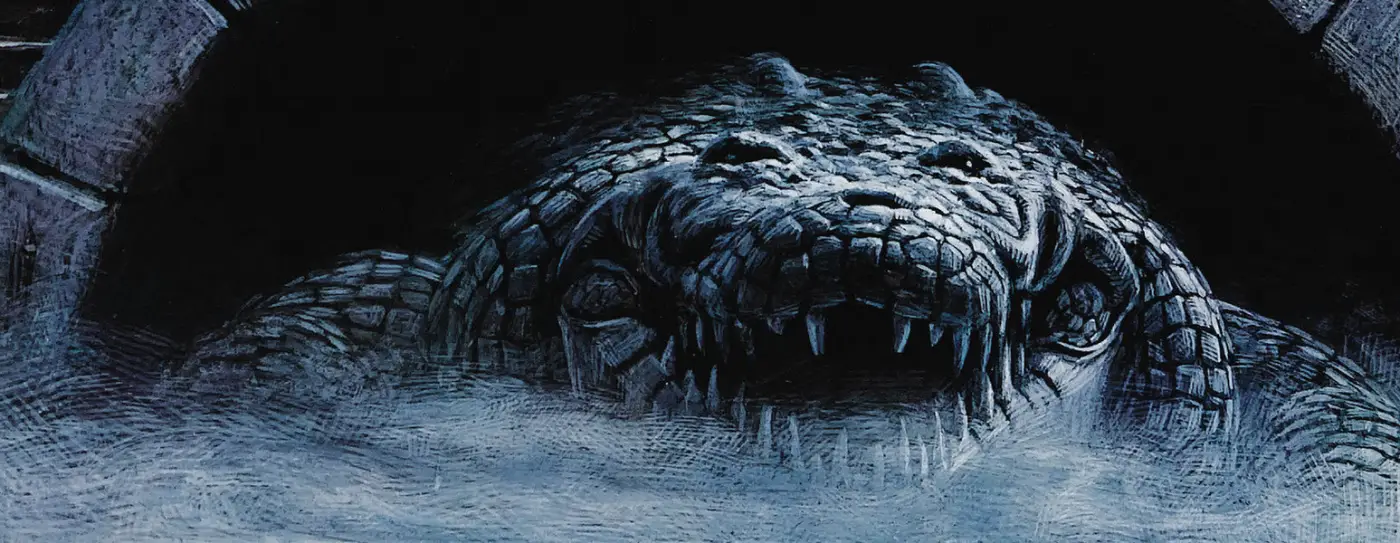The “giant killer animal” subgenre of horror flicks has been in a terrible state of disrepair as of late. Personally, I blame the Sci-Fi Channel or the Syfy Channel or whatever stupid thing they’re calling themselves. With their cheap, stomach-turning “Original Movies”, they’ve pretty much flooded the subgenre with one giant CG shark movie after another.
So for all of you who have had to suffer through those recent cinematic abortions, I urge you to purge them from your mind and look back at some of the older cinematic abortions that comprise the formative years of the “giant killer animal” subgenre. I’m talking about flicks such as Piranha, Orca: The Killer Whale and, case in point, Lewis Teague’s Alligator.

The year is 1968 and a baby alligator finds itself being helplessly flushed to its doom. As fate would have it, a research firm decides to start dumping (illegally, mind you) genetically mutated dog corpses deep down in the stagnant sewer depths. So, what happens when a baby alligator starts chowing down on dead mutant puppies? A thirty-six foot super alligator, naturally. Fast forward to “today”, a cop (Robert Forester) and a reptile specialist (Robin Riker) are charged with the unenviable task of finding and killing this gigantic eating machine before it decides to step out of the sewers and onto the streets.
Their progress is mixed, at best.

Alligator hit theaters only five years after Jaws (and only two years after Jaws II) and is pretty shamelessly trying to ride the success of Steven Spielberg’s blockbuster. As much as I’ll confess to loving Alligator, there’s no denying what inspired it. And yet, in a few ways, the film actually manages to improve upon its inspiration, if you’re willing to buy that. Primarily, what Alligator pulls off that Jaws never quite could was to visually bring its monster to life. As much as I adore
The gator prop is constantly shrouded in darkness during the sewer sequences, which adds a great deal of atmosphere and dread to the moment (as well as masking some of the puppet’s inadequacies, I’m sure). In one of the film’s best moments, Robert Forester and his expendable sidekick are trying to read a map with a flashlight and as the beam of light swings about behind them you very briefly glimpse the monster.

The effects aren’t all worthy of the proverbial thumbs up, though. Although mercifully brief, a few scenes feature an actual-real-live-alligator walking down a model city street and ohhhhhhh man, what were they thinking?

Teague also employs a few directorial techniques ripped directly from the film’s inspiration, Jaws, and only manages to cheapen the experience for the viewer. These bits include moments shot from “alligator-vision” as a theme noticeably similar to the John Williams Jaws tune churns out. Alligator had enough going for it that it really didn’t need to purloin such ideas from Jaws and could have stood on its own two feet well-enough. Unfortunately, these aspects of the film are what a lot of people remember best and have eternally relegated the flick to “shameless Jaws knock-off” status.

I won’t say that Alligator is a perfect horror flick. There are loads of textbook incidental characters such as a “no-nonsense police chief”, a “dirty mayor” and an “evil corporate executive” who pretty much grate on your nerves from start to finish. And yet, if you can get past these low-points, you’ll find one of the better “giant killer animal” movies on the market. And considering how packed that sub-genre is with made-for-TV refuse, this is definitely a rare treat.
Join the AIPT Patreon
Want to take our relationship to the next level? Become a patron today to gain access to exclusive perks, such as:
- ❌ Remove all ads on the website
- 💬 Join our Discord community, where we chat about the latest news and releases from everything we cover on AIPT
- 📗 Access to our monthly book club
- 📦 Get a physical trade paperback shipped to you every month
- 💥 And more!












